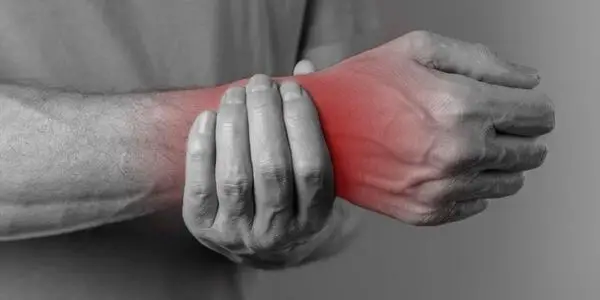Doing push-ups is a great way to strengthen your upper body, but experiencing wrist pain is a red flag.
In this blog post, we will discuss the causes of wrist pain when doing push-ups and offer actionable solutions.
We will provide tips for modifying the exercise to make it more comfortable for your wrists, alternative equipment, and many more. Keep reading to learn more!
Table of Contents
Why Am I Getting Pain In My Wrist With Push-Ups?
If you’re getting wrist pain when you’re doing push-ups, you may have one of the conditions below:
Carpal Tunnel Syndrome
Carpal Tunnel Syndrome is one of the most common nerve disorders, affecting millions of people each year. The condition is caused by compression of the median nerve, which runs through a narrow passageway in the wrist (the carpal tunnel).
This pressure can cause numbness, tingling, and weakness in the hand and fingers. In severe cases, Carpal Tunnel Syndrome can lead to loss of hand function.
The good news is that there are many effective treatments for the condition.
In mild cases, simple lifestyle changes such as ergonomic modifications to your workstation can help to relieve symptoms. More severe cases may require medication or surgery. With proper diagnosis and treatment, most people with Carpal Tunnel Syndrome can regain full use of their hands.
Tendosynovitis
Tendosynovitis is the inflammation of a tendon, the tough, fibrous cord that attaches muscle to bone. It can be caused by overuse, repetitive motion, or direct trauma to the affected area.
Symptoms include pain, tenderness, swelling, and warmth. In severe cases, the tendon may rupture.
Treatment typically involves rest, ice, and anti-inflammatory medication. Surgery may be necessary in some cases.
Wrist Sprain
A wrist sprain is an injury to the ligaments in the wrist. The ligaments are the tissues that connect the bones.
A wrist sprain occurs when these ligaments are stretched or torn.
Wrist sprains are generally caused by a fall or blow to the hand or wrist. Symptoms of a wrist sprain include pain, tenderness, swelling, bruising, and difficulty moving the affected joint. Treatment typically involves rest, ice, compression, and elevation (RICE).
More severe sprains may require immobilization in a splint or cast. Surgery is rarely necessary.
With proper treatment, most people fully recover within four to eight weeks. However, some people may experience long-term complications such as stiffness, weakness, and joint instability.
Compressed Ganglion Cyst
A ganglion cyst is a fluid-filled sac that develops near a joint or tendon. They are most commonly found on the wrist but can also occur on the ankle, knee, and elbow.
Ganglion cysts are usually benign (non-cancerous) and not painful. However, they can cause pain if they press on a nerve or become inflamed.
Treatment typically involves draining the cyst with a needle or surgically removing it. Most people make a full recovery with no long-term complications.
Weak Wrist
Sometimes, your wrists can hurt because they’re not strong enough to support your body weight while doing push-ups.
That brings us to the following question:
How Can You Strengthen Your Wrists for Push-Ups?
You can strengthen your wrists for push-ups in a few different ways. Below, we will discuss some of the most effective methods:
Wrist Curls
- Sit on a bench with your palms facing up.
- Then, holding a dumbbell in each hand, slowly curl your wrists up and down.
- As you get stronger, you can increase the weight of the dumbbells.
Reverse Wrist Curls
This exercise is similar to the regular wrist curl, but instead of holding the dumbbells with your palms facing up, you will hold them with your palms facing down.
Wrist Rolls
- Sit with your back straight and your legs crossed.
- Take your right hand and place it on top of your left wrist.
- Gently roll your left wrist in a circular motion for 30 seconds.
- Repeat with the other hand.
Prayer Stretch
- Bend your elbows and place your palms together beneath the chin.
- Lower your palms until you feel a stretch.
- Bring your palms up again for one rep.
- Complete twenty reps.
Ball Squeeze
- Sit on a chair with your feet flat on the floor and a stress ball in each hand.
- Squeeze the balls as hard as possible for 30 seconds.
- Release and repeat five times.
Should You Do Push-Ups if Your Wrist Hurts?

You shouldn’t do push-ups if your wrist hurts because you could aggravate the condition. However, there are some modifications you can make to the exercise to make it more comfortable for your wrists.
We’ll discuss these in the sections below:
How Can I Prevent Wrist Pain When Doing Push-Ups?
You can do several things to prevent wrist pain when doing push-ups:
- Ensure your hands are in line with your wrists. You should not be “flaring” your elbows out to the side or placing your hands too far forward or back.
- Keep your palms as flat as possible when doing the exercise. You can also place a fitness mat under your palms for added cushioning.
- Warm up before you do any strenuous exercise, and cool down afterwards. Wrist stretches are a great way to warm up your muscles and reduce your risk of injury.
Push-Up Modifications to Avoid Wrist Pain
If your wrist still hurts during push-ups, even after following the advice above, try the modifications below. These exercises aim to reduce the weight pushing on your wrists and their standard bent position.
The more you push on those wrists and bend them, the more likely you are to feel pain.
Besides, these modifications will help strengthen your wrists so that you can eventually transition to traditional push-ups.
Wall Push-Up
- Start by standing with your feet shoulder-width apart and your hands on the wall at shoulder height.
- Lean forward so that your body is at a slight angle to the wall and then bend your elbows to lower your chest towards the wall.
- Once your nose is about an inch away from the wall, pause and press back to the starting position.
- That’s one rep. Repeat for 10-12 reps, and then take a break. Do 2-3 sets.
Fist Push-Up from Your Knees
- Start in a modified push-up position with your knees on the ground and your hands in fists.
- Bend your elbows to lower your chest towards the ground. Once your chin comes close to touching the floor, pause and then press back up to the starting position.
- That’s one rep. Repeat for 12-15 reps, and then take a break. Aim for two sets.
Knee Push-Up Using Push-Up Bar
- Start in a modified push-up position with your knees on the ground and your hands on a push-up bar.
- Bend your elbows to lower your chest towards the ground.
- Once your chin comes close to touching the floor, pause and then press back up to the starting position.
Push-Up Alternatives to Avoid Wrist Pain
You don’t necessarily have to do push-ups to work your chest, upper back, and arms. You can consider using the following machines:
- Chest press machine
- Lat pulldown machine
- Rowing machine
- Bicep curl machine
- Triceps pushdown machine
The advantage of these machines is they keep your wrists straight instead of bending them. That bend leads to pain, triggering existing conditions or causing new problems.
Wrap Up
Wrist pain is not uncommon during push-ups, but that doesn’t mean you should ignore it.
Try to figure out what’s causing it and improve your form. Alternatively, try to strengthen your wrists by doing the modifications above or using some other gym equipment.
If you’re still experiencing wrist pain after trying these modifications, consult a doctor or physical therapist. You may need to adjust your form further or try a different exercise altogether.
Wrist pain is no joke, and it’s important to listen to your body and take care of yourself to prevent further injury.
- What Happens To Your Body When You Do Dips Every Day - June 28, 2024
- 9 Push-Up Mistakes You Might Be Making (And How to Fix Them) - October 10, 2022
- The Complete Guide to Mastering Upper Chest Push Ups - October 10, 2022

